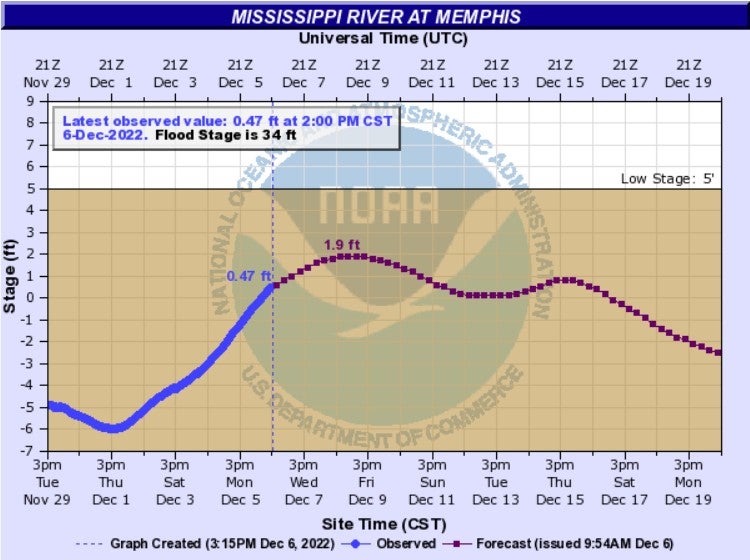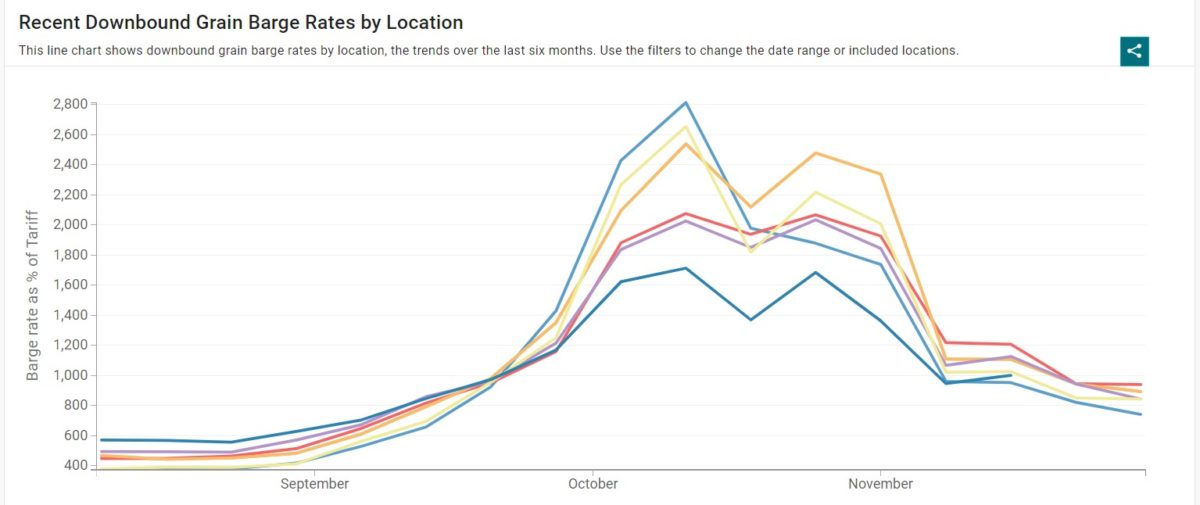Shipping conditions on the lower Mississippi River are starting to return to normal as rain has picked up and water levels have improved.
Measured at the key point of Memphis, Tennessee, water levels have made a dramatic improvement in just the past few days after several weeks of more gradual increases.
The National Weather Service on Tuesday listed the depth at 0.47 feet above the zero stage, which does not mean there is no water in the river. Rather, it means there is a measurement starting point at roughly 5 feet of depth, and measurements are made in relation to that base.
At the end of October, that measurement hit negative double digits. On Oct. 18, according to Coast Guard data, the level was negative-10.7 feet at Memphis, tying a recent historic low set in 1988.
But now the 0.47 level is up from the roughly negative-6 feet recorded as recently as Dec. 1. The level is expected to reach 1.9 feet sometime Thursday or Friday. Restrictions on barge shipping ease as the water level rises.

In October, the U.S. Coast Guard said that a closure near Memphis at one point had led to a backup of 51 vessels and 710 barges trying to head south. In an email to FreightWaves, the Coast Guard said there were no backups at Memphis this week.
When asked about current restrictions, the Coast Guard station in Memphis forwarded a list that is dependent upon water levels.
A southbound tow of barges when the river is down at the minus-5 level is restricted to a grouping of barges six wide with a draft of no more than 10 feet.
The limitations ease as the water levels rise. When it is above minus-1 — where it is now but only recently — the restrictions go up to seven wide and a draft of 11 feet, 6 inches.
“It’s definitely a lot better,” Mike Steenhoek, executive director of the Soy Transportation Coalition, whose members are major users of the Mississippi primarily to move soybeans to Gulf Coast ports for exportation, told FreightWaves.
Steenhoek said in late October he would tell people that traffic on the Mississippi was like going from a five-lane freeway to one lane. Traffic now has “significantly improved,” though he only put it at the equivalent of two lanes.
Barge rates have reflected the better situation on the river. A Department of Agriculture table showing barge rates expressed as a percentage of a base rate, for Downbound Grain Barge Rates, stood at 842.34 on November 29 for traffic south of St. Louis. On October 25, it was 2,216.67.

One problem continues to be the Mississippi River between St. Louis and Cairo, Illinois, where the Ohio River joins it to add a huge new source of water. That traffic remains more restricted, according to Steenhoek, but traffic north of St. Louis is now closed for the winter season.
In a recent blog post, the American Commercial Barge Line wrote that the upper Mississippi north of Cairo is “forecast to see an increase in restrictions due to a deteriorating river stage [from] St. Louis through Cairo.”
In the key Memphis area, Steenhoek said barge companies have been telling his organization that “a lot of these restrictions have abated. They’re able to load heavier but not quite up to normal.”
Steenhoek said the level of loading is up to 10.5 feet of draft on the lower Mississippi, up from the restrictions around 9 feet just a few weeks ago even though the aforementioned Coast Guard guidelines call for more. In normal times, Steenhoek said that figure can rise to 12 feet.
He added that the current limitations are often those voluntarily agreed to by barge companies who “don’t want to get stuck on a sandbar.”
The number of barges that can be put together in what Steenhoek called a “Jenga puzzle” now has risen to seven across in “certain spots.”
That Jenga puzzle can be as many as 40 barges in normal times and put together in a variety of ways, he said. At one point, it sank to as few as 20 barges connected to each other.
“Now it’s getting closer to 30,” Steenhoek said. “It’s clearly getting better but not to normal conditions.”
More articles by John Kingston
Drivers oust Teamsters at Home Depot subsidiary in California
Truck transportation jobs move little in November but trend still upward
California tank truck companies’ owner gets 10 years for fatal explosion, other crimes
The post Water rising on Mississippi, barges moving more freely south of Memphis appeared first on FreightWaves.
